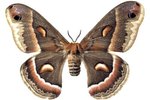
Texas attracts grasshoppers with its droughts and dry open habitats. A swarm of grasshoppers can fly over 15 miles a day, feeding on grass and crops as it goes. Grasshoppers' positive impact on the ecosystem comes from their ability to provide nutrients and fertilizer to plants, thereby linking plants to the rest of the ecosystem.
Red-Legged Grasshopper
The red-legged grasshopper (Melanoplus femurrubrum) has a yellow-green tone on its abdomen and red-black or olive-green tones on its back. Its full adult size is 1 inch. These insects feed on alfalfa, legume plants, grains, potatoes, cabbage, beans, beets, corn and tobacco crops. They are known to fly up to 40 feet when frightened. Red-legged grasshoppers prefer a sunny, grassy, moist habitat in low areas. They are commonly found in yards, fields, crop borders, prairies and meadows. During droughts, long wings develop on adult red-legged grasshoppers, allowing them to fly farther in search of new sources of food.
Two-Striped Grasshopper
Melanoplus bivitattus, also known as the two-striped grasshopper, has two pale-yellow stripes running from its eyes to its wingtips. These grasshoppers feed on grasses, alfalfa, vegetables, weeds, shrubs and trees. They prefer to stay close to edges of streams, fields, marshes and wherever they can find lush growth and plant sources. Nymphs consume a leafy diet of prairie sunflower, lettuce, ragweed, chicory, greenflower, dandelion, pepperweed, alfalfa, red clover and plantain. This variety of food sources provides nymphs with nutrition that results in heavy weight, fast growth and high survival rates.
Packard Grasshopper
The habitat preference of Melanoplus packardii, the Packard grasshopper, is desert prairies, sandy soil, mountain meadows and areas of tall, short and mixed grass. Packard grasshoppers have brightly colored brown-and-yellow patterns on their wings and bodies. Tan stripes run from their heads to the tips of their wings. They prefer to feed on the stems, flowers and leaves of plants, in addition to consuming cereal crop fields.
Migratory Grasshopper
Melanoplus sanguinipes, commonly referred to as the migratory grasshopper, is known for being destructive to cultivated crops. It has dark markings and is light brown in color. Favored habitats include sandy soils, overgrazed land sites and weeds. Migratory grasshoppers swarm for long distances and are known to destroy fields of vegetables, alfalfa, oats, corn, wheat, clover and barley. They also feed on fruit, foliage, bushes, vines and tree bark. The migratory grasshopper is extremely active during the day and inactive at night.
References
Resources
Photo Credits
-
Jupiterimages/Photos.com/Getty Images
Writer Bio
Based in Miami, Shellie Alyssa has been writing articles since 2011. Her articles have appeared on a variety of popular and informative pet websites including munch.zone. In 2000, she was awarded an editors choice award for Outstanding Achievement in Poetry from the International Library of Poetry. She holds a fashion merchandising diploma from Penn Foster College.




